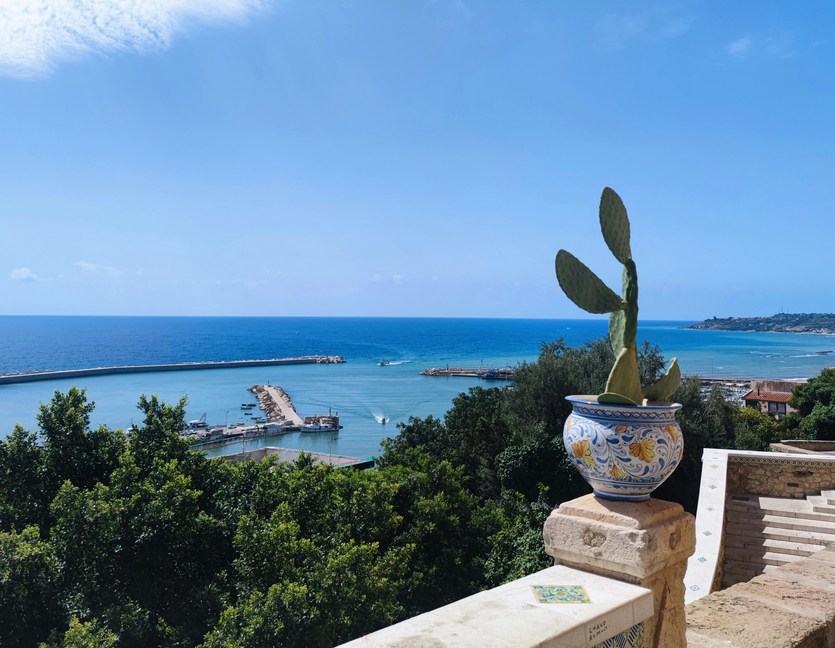Discover Sciacca, Sicily: A Guide to Its Historical and Natural Beauty
Thanks to its rich historical past, Sciacca in Sicily feels like a small medieval town that gracefully descends towards the sea. Its strategic position near Selinunte and thermal springs led the Romans to refer to it as Thermae Salinuntinae. However, the current name derives from the Arabic word “as-saqah,” meaning “water.” As you explore the historic centre, you’ll find a maze of narrow alleys and courtyards influenced by Arabic architecture, ultimately leading to the picturesque marina.
Along the way, discover significant landmarks such as:
- The city gates
- The Mother Church dedicated to Santa Maria Maddalena
- Steripinto Palace, a prominent example of Catalan Gothic civil architecture
Don’t forget to stop by the craft shops, where skilled artisans create beautiful traditional ceramic items—perfect for a memorable souvenir! If you’re a fan of festivities, visit the local museum dedicated to the Carnival, an event of great importance to Sciacca.
Important Attractions in Sciacca
Castello Luna
Dating back to the 14th century, Castello Luna is situated on the highest point of Sciacca, offering breathtaking panoramic views of the surrounding area. You can still see remnants of the original fortress, including the base of the large tower and the two-storey cylindrical tower, along with the historic Count’s Palace. The entrance fee is €3.00, and it is open daily except Mondays from 9:00 AM to 1:00 PM and from 3:00 PM to 7:00 PM.
Castello Incantato
Just outside the historic centre lies Castello Incantato—a striking garden featuring diverse plant life, including numerous almond and olive trees. Here, sculptor Filippo Bentivegna has created distinctive artworks from rocks and tree trunks, complemented by a charming small labyrinth. Admission costs €3.00 for adults, with summer hours from 9:00 AM to 9:00 PM and winter hours from 9:00 AM to 1:00 PM and from 3:00 PM to 5:00 PM.
San Calogero Hermitage
On Mount San Calogero, a few kilometers from the historic centre, you will find the Hermitage of San Calogero. This site is believed to be where the saint healed the sick. Visitors are drawn here, especially due to the nearby thermal complex known as Stoves of San Calogero and the enchanting Kronio Caves.

On Mount Kronio, therapeutic vapours are found in the karstic hypogea, making it a site worth visiting. Interestingly, Mount Kronio is named after the mythological figure Cronus, believed to have lived in the caves created by Daedalus, the famed builder of the labyrinth on Crete.
These caves also served as grain storage before being transported by sea. A fascinating feature is the mysterious connection between underground Sciacca and the submerged Ferdinandea Island lying in the Sicilian Channel. The Caricatore Caves are open to visitors from Monday to Saturday from 9:00 AM to 12:30 PM and from 6:30 PM to 8:30 PM, with an entrance fee of €2.00.
Exploring Sciacca’s Beaches
Sciacca offers an array of stunning beaches, catering to various tastes. Among the notable seaside destinations is Capo San Marco, featuring beautiful golden sands and crystal-clear waters. This area is equipped with services, while still embracing its natural charm, where you may even spot sea turtles.
For a quieter experience, visit Rocca dei Tuffi and Testa di Crasto. These tranquil beaches allow you to enjoy nature and Mediterranean flora with fewer facilities, which is ideal for those seeking solitude.
The popular beaches of San Giorgio and Sovareto are also worth a visit. San Giorgio is easily accessible and features clay suitable for beauty treatments, while Sovareto is conveniently located and favored by many sunbathers.
Additionally, the closest beaches to the centre include Tonnara and the beach of Contrada Foggia. At Tonnara, remnants of an old tuna processing facility can still be observed, making it a paradise for snorkeling enthusiasts due to its rich marine life. Meanwhile, Contrada Foggia is family-friendly and provides ample space for sports activities.
If you’re eager to explore further afield, consider a trip to Selinunte, home to the Belice River Nature Reserve. Here, you will discover an array of beaches from wild and untouched to more developed. Casello 11, one of the most renowned locales, is named after an ancient railway tollhouse and might even present sightings of free-roaming donkeys.
Alternatively, head in the opposite direction to Pianagrande, a large pebbly beach characterized by its stunning blue waters. Visitors have access to equipped areas, kayak rentals, or can simply soak up the sun at the free beach.
In conclusion, your visit to Sciacca promises to be a delightful and rejuvenating experience. With a perfect blend of history, culture, and stunning natural landscapes, Sciacca is a hidden Sicilian gem just waiting to be explored.
Have you ever explored Sciacca? Feel free to share your tips and experiences below!




